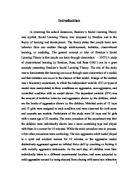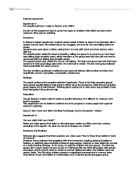The general concept of Bandura’s Social Learning Theory and its main study give clear idea of the subject and help to reach the aim of the observation in a lower school classroom of the school.
AIM :
To Investigate How Bandura’s Social Learning Theory Is Applied In An Elementary School Classroom.
Method
Design
Independent Variable (IV) – A Type Of Model
Dependent Variable (DV) – The Amount Of Imitative Behavior
Observation:
A common research method observing subjects used by psychologists and other social scientists.
Different behaviors of a model were exposed to children of Grade 3 in order to see how the model uses observation learning to the children consequently led to the acts of imitation of Bandura’s Social Learning Theory.
Ethical Considerations
Informed consent was given from the classroom teacher.
Participants
-
Mr. A (Model) – A 3rd Grade Teacher
Age: 35 Years
Gender: Male
Procedure
Apparatus: (See Appendix I)
(A Paper With Divisions Of Behaviors For Positive And Negative Markings)
Procedure:
-
Grade 11 Students of IB Psychology Class joined a 3rd Grade Classroom at the Elementary School.
- Model of the observation, Grade 3 Teacher, was being observed of his teaching behaviors by the students of Psychology Class for about 20 minutes, and the results were recorded on observation schedule sheets.
- The students or researchers of the observation investigated and determined how Bandura’s Social Learning Theory was applied in the observation, and how it led to the imitative behaviors of the children.
Results
- See Appendix I For Collected Raw Data
Discussion
Bandura’s Social Learning Theory is a theory where people can learn their own behaviors with the information obtained in observing other people. It shows imitation, and it demonstrates that practical or substantial behaviors and instant rewards are not necessary for the study in order to get reactions of others. It also has the main concept in mental process of perception, which includes memory, observation, mental capacity, verbalism, creativity, and originality. – Bandura [1977]
The table of the teacher’s behaviors showing positive and negative markings of an each group describes that the teacher gave only one positive merit to a child in the classroom and none of the negative ones. He also verbally commanded in a negative way about 15 times, but only twice positively. The difference in verbal commands was very gradual as it is illustrated in the graph. Voice tone of the teacher was also changing, but negative tone of the voice was twice more than the positive or the nicely speaking tone. Facial expressions were effective to the reactions of the children, so he was diverse in using facial expressions. The teacher of the lower school classroom used some of the body language, but they were not as effective as facial expressions. So he was in control of using body language signs to the children. Eye contact can be included in body language, and the teacher showed a lot of positive eye contacts while speaking or referring to the children. As the result of the teacher’s observation, it was demonstrated that he was in full control of getting reactions of imitative behaviors of the children.
In this observation, a teacher’s behaviors towards children in a lower school classroom were observed, which are very easy to be imitated by children through the teacher being a model to them. Characteristics of the teacher’s behaviors were divided into six groups. In the results, there were no clear features in the group of merits. However, the group of verbal commands, getting 15 negative marks, was the achievement of the most marks than in any other groups. As a first reason, it can be that the teacher has an inclination for verbal commands. The second reason might be that the teacher guides young children using verbal commands on purpose, since the kids are easily distracted. In the group of voice tone, the number of negative marks was twice bigger than the number of positive marks. This also can be viewed as a similar reasoning to that of the group of verbal commands. On the other hand, the group of facial expressions had a lot more positive marks than negative marks, which was the same happening as the groups of body language and eye contact. As in the results, the groups of facial expressions, body language, and eye contact, or indicators of behaviors, obtained the most positive marks, which mean that the teacher devoted himself to children with different expressions, actions, and stronger verbalism in order to catch their attention. This was why the group of verbal commands got the most negative marks, since little children need relatively more powerful speech for their distraction. So as the teacher showed his behaviors, children concerned more about the teacher’s expressions as a model of imitation.
According to Bandura (1977), observational learning is made through the process of four steps, such as attention, retention, reproduction, and motivation. The structure of Social Learning Theory becomes imperfect without successful imitation, even if one of these four steps of observational learning is left out. Now that in order to make a progress of an observational learning, total attention is required to the model. If the model does not get the full attention, it becomes impossible to imitate the model. As a next step, retention of the observed behaviors is needed for the imitation, and reproduction is also essential in order to perfectly reform the imitation of the model. It is never done only by observing reproduction, but it calls for physical growth, maturation, and lots of practice. – [1977] Young children can gain new knowledge through observing the model. Nevertheless, motivation is required to perform this study, where the children get it through the model’s merits in their own observations. Yet, the kids in elementary school in this observation were more effective in facial expressions, body language, and eye contact for attention and retention, rather than in verbal commands or in voice tone. Verbal commands were not very successful in gaining children’s attention or motivation. However, this fact is only under premise that the teacher clearly knows which behaviors can get the children’s attention in their observational learning habits. In general, this observation proved that it is easier to get the children’s attention through gestures or expressions.
As a main strength of the observation, the teacher’s process of attention and retention for children in observational learning was very good. Methodologically, the observation also had clear IV and DV. Punishment or negative marks of the groups of behaviors bring undesirable behavior to the attention to avoid future punishment. On the other hand, merits or rewards provide information on desirable behavior, increase motivation in performance, and are associated with pleasant emotions.
The biggest weakness of the observation was that it would have been better, if more diverse types of observations were used to get the children’s attention. Basically, it means that there was no reproduction, nor motivation in the process of the observational learning. Also, more groups of behaviors for observations would have been much helpful in developing the main concept of the research study. Lack of attention, disruptive behavior, insufficient quality of the observation, and lack of control in observing the model can also be the negative criticisms. Negative marks of the behaviors can create undesirable behavior with further negative feelings and various effects.
In order to improve the observation, the exact process of four steps in the observational learning is necessary. Strengthening the group of merits in observing would be helpful, since it plays a great role in finding the children’s motivation. This research study should not be the observation of the teacher only, but also of the children and the interaction between the teacher and the children. It is hard to find the children’s attention or motivation towards the model only by watching the teacher’s behaviors. Bandura (1977) said that the gained information through the study can only be carried on within its indispensability. More trials of the observation can make the results closer to the actual Social Learning Theory of Bandura (1977).
For the areas of future study, the importance of attention, one of Bandura’s four steps of observational learning, was given out through this research. In the process of attention, the chance of imitative behaviors gets higher as the more attention is given to the model’s behaviors in the observation. Therefore, the teacher, who was the model of the observation, was sufficient enough in getting the attention of the children. The children observed the teacher’s facial expressions, gestures, and verbalism very carefully, so the study clearly prompted that there is more probability of their imitative behaviors. – Bandura [1977]
Conclusion
In the observation, the obtained results tend to show that the model was tightly controlled in showing off his behaviors. The children of the researched study reacted almost like as the predicted behaviors. They showed imitation, which is a reflection included in Bandura’s Social Learning Theory. As Bandura’s Social Learning Theory states, the children have learned new behaviors from the model through imitation, observational learning, and modeling which was the whole purpose of this observation.
References
-
Bandura, A. (1977), Social Learning Theory, New York, Prentice Hall
-
Bandura, A. / Ross, D. / Ross, S.A. (1963), Imitation of Film-Mediated Aggressive Models, Journal of Abnormal and Social Psychology, 66 (1): 3 – 11
Appendices
- See Attached Paper At The End Of The Internal Assessment Packet.
- Raw Data







